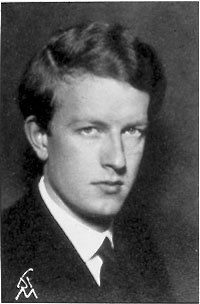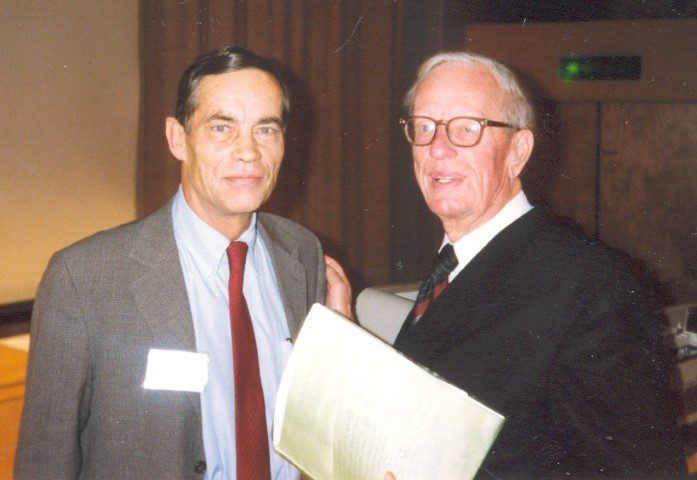Frank Wollheim
Sweden

Jan Waldenström (JW) grew up as the only child of Elsa and Henning Waldenström on the green island Lidingö bordering Stockholm. On Sundays father and son went for long walks enjoying nature (Fig 1). The father, professor of orthopedics at Karolinska, told the boy about his work, for instance that liver amyloidosis secondary to osteomyelitis or tuberculosis in children could be reversed when the infection healed, and about his conviction that metabolic disturbances were the cause of many diseases. His grandfather was professor of internal medicine in Uppsala, and his great-grandfather was the county medical officer of a huge district in the north of Sweden. Clearly Jan felt inclined to continue this tradition. But interest in the humanities and culture made him choose Latin as a major subject in high school rather than biology, although biology was taught by his favorite teacher.1
In medical school at Uppsala University from 1924 he was member of a “Matlag” where about ten students from all faculties met for the evening meal usually followed by “endless discussions at fireside, consuming chestnuts and cheap red wine,” gaining insight and founding lasting friendships.1 A frequent guest was Dag Hammaskjöld.2 JW’s favorite professor was August Hammar, an expert in endocrinology who had published two extensive volumes on the thymus, the function of which, however, remained obscure. Robin Fåhreus was the most famous of the teachers, having rediscovered the sedimentation rate and developed it into a useful routine test. His mother was a prominent actress and according to JW he had more of her skills as actor than as teacher.1 JW’s own interest in basic science was nourished during a fall visit in 1927 to Cambridge by encounters with JBS Haldane and the later Nobel Laureate Fredrick Gowland Hopkins.
In 1933 JW began his internal medicine residency at the Uppsala Academic Hospital. He soon encountered a young female patient suffering from an unclear acute febrile illness with painful abdominal cramps and encephalitis-like symptoms, and noticed that she passed red urine. On examining the urine with a spectroscope, he found that the diagnosis was porphyria, then considered to be extremely rare. JW became immediately interested and in a short time found the hospital records of twelve similar patients and published his first paper.3 Much to his later regret, he wrote in this paper “but I was not in the position to demonstrate any hereditary factor.”3 This was based on the case records where heredity was denied. The mistake became a lesson for life; JW never trusted what others had written in hospital charts. JW now wanted to investigate the fundamentals of porphyria and thanks to the wisdom of Alan Gregg, director of the Rockefeller Foundation, he received in 1934 a stipend enabling him to join world expert Hans Fischer in Munich, recipient of the 1930 Nobel Prize for his synthesis of the red blood pigment. Fischer was a master crystallizer, and his skill in crystallizing unknown biologic substances opened the way to their identification. Deeply unhappy with the Nazi regime, he told JW in private ”Sie machen alles kaput” (they wreck everything). As we know his prediction was right and in 1945 Fischer committed suicide. On returning to Uppsala in 1935, JW and his wife told their friends and relatives that Germany was ruled by a set of gangsters and that it would lead to a big catastrophe. Most people did not believe this, but “stared at us and thought of Schiller and Goethe.”3 In coming years JW was one of the few Swedish physicians who tried to convince the authorities to allow immigration of refugee colleagues from the Nazi regime.
JW defended his PhD thesis in 1937.4 It begins with a chemical part where he presents the features of a new poryphyrin, Uroporphyrin III, later named porphobilinogen, found only in the urine of patients with acute intermittent porphyria. In an extensive clinical part he detailed the clinical features of no fewer than 103 patients, sixty-seven women of whom forty-eight died young during attacks. The birth places showed clustering in the northern half of Sweden, and pedigrees based on increased excretion of urooporphyrin III indicated an autosomal dominant inheritance. Asymptomatic family members excreting porphyrin could upon exposure to sedatives or sulfonamides develop severe disease. Several young misdiagnosed patients died after acute abdominal surgery. One extended family contained nine cases in three generations. In time this family consisted of 100 individuals and was depicted on a twelve feet wide scroll which JW still used for undergraduate teaching thirty years later. JW acknowledges that Arthur Engel, the chief at the department of medicine in Boden in the north, helped him collect the data of this family and that they traveled to the homes of patients and relatives to collect their urine.

in Uppsala
Blood diseases became a new interest of the now young “docent” (assistant professor). Stimulated by a monograph authored by the German professor Ludwig Heilmeier, JW embarked on a major study of iron deficiency anemia, which turned out to be more common in rural areas where meat consumption was low.5 But working near the giants The Svedberg and Arne Tiselius at the department of Physical Chemistry, JW became interested in the largely unexplored conditions with hyperglobulinemia. In 1943 he identified three cases with a high globulin concentration and relapsing purpura mainly on the legs, often precipitated by “bodily exertions.” With time these patients were left with characteristic pigmentations.6 This benign condition was soon called Purpura Hypergobulinemica Waldenström, as similar cases were described by several other authors.
A more severe hyperglobulinemic condition was multiple myeloma, characterized by increased plasma cells in the bone marrow and painful bone lesions. JW identified two patients with “incipient” myelomatosis who instead of plasma cells had lymphoid cells in the bone marrow, low platelet counts, low fibrinogen, and bleeding from the mouth and eyes but no purpura. JW went with blood specimens from these patients to his friend KO Pedersen, in charge of the ultracentrifuge in the Svedberg institute. They noticed an unusual component in the 19S region and published the findings in 1944.7 A new disease had been discovered, soon named macroglobulinemia, also known as Waldenström’s disease. JW, still in his thirties, had made it to the Parnassus of medical research.
Sweden’s relative isolation during the Second World War motivated the surgeon general Axel Höjer and the secretary of state Tage Erlander (later to become Sweden’s prime minister) to send JW on a seven month fact finding mission to the USA in 1943. JW visited leading hospitals and research institutions and formed lasting friendships with leaders in basic and clinical science.1 He visited the Rockefeller Institute, meeting his benefactor Allan Gregg, and also Otto Loewi, who had recently arrived from Europe.
At Columbia he met Shemin and Rittenberg, co-workers of the late German émigré Rudolf Schönheimer. Their isotope labeling technique now made it possible to study the metabolic pathways of porphyrins. In Boston he met the Russian arrival Damasheck and the Austrian émigré Henry Stratton. They were discussing the name of a new hematologic journal, and JW successfully voted for “Blood.” JW was later to become the first of the distinguished Henry M. and Lillian Stratton Lecturers of the International Society for Hematology. He also met the legendary William Castle and George Minot. Fuller Albright was already suffering from severe Parkinsonism, but impressed JW by stressing that research must be fun. At the Mayo Clinic he met Hargraves, who was soon to discover the LE-cell. In St. Louis he encountered Carl Moore. In Minneapolis he became friend with Cecil Watson, who had also had spent time in Hans Fischer’s lab in Munich. These and several others later would contribute to the academic life in Malmö, where JW was professor of internal medicine from 1950 until his retirement in 1972.
In 1950 JW was an invited speaker at the German gastroenterology meeting in Bad Kissingen, Bavaria. He gave a talk about a group of girls around puberty with chronic liver disease, modest and sometimes intermittent jaundice, spider naevi, and high concentrations of gamma globulins. That same year Henry Kunkel et al. from the Rockefeller read a paper about similar young women at the American Society for Clinical Investigation meeting in Atlantic City. Their striking feature was a prompt response to ACTH. The nickname Kunkel-Waldenström girls was first used for this condition, later becoming known as “lupoid hepatitis” or chronic active hepatitis. JW never published this important observation in an accessible paper.8

Medical Association congratulates the current
president Göran Bauer. Photo by FW taken in
Stockholm in 1989
Soon after JWs arrival in Malmö a young man was admitted with pulmonary stenosis, marked cyanosis, and “curious changing vasodilatation of the skin.” He died and the autopsy revealed the surprise finding of metastatic carcinoid tumor. Months later JW came across a second patient with similar features. Such observations had been made earlier, but JW pursued the metabolic background and thus discovered the carcinoid syndrome.9,10 Again, the key to discovery was exploring in depth a single unusual patient and linking the clinical picture to the laboratory findings.
Another major contribution by JW in Malmö was the elucidation of conditions with elevated gamma globulins. In close collaboration with Carl-Bertil Laurell (a friend from Uppsala and now professor of clinical chemistry in Malmö) and others he recognized the difference between monoclonal neoplastic and polyclonal reactive hypergammaglobulinemias.11 He emphasized that the abnormalities could remain silent for long periods during which no therapy was required.
Thus JW’s success as clinical investigator was closely tied to his keen interest in individual patients and to an extraordinary sharp memory for cases he had encountered. The individual patient was always the most important source of information. Throughout his twenty-two years as professor in Malmö he was active in the outpatient clinic two to three days a week and made ward rounds every other day, often on Saturday afternoons – until the nursing staff made him give up this habit. His rounds were unsurpassed teaching events for students and house officers and staff, and a check on our performance long before quality control became in fashion. JW would share the news from his most recent visit to other hospitals around the world. International friends who met him around the world would ask: “Who is in charge of your department when you are away?” JW answered “The same people as when I am at home.” His authority, however, was absolute. His frequent absences fostered independence and many of his trainees later filled key positions in Swedish hospitals.
JW was a most inspiring mentor and a charismatic, though sometimes frightening, teacher. When in 1966 I told him of my work on secretory IgA his face brightened and he said: “Now I understand why dogs lick their wounds.” In the final examination of medical students they had to first work up two patients. Only if this was done to JW’s satisfaction would he proceed to the proper oral examination. This often took place in the evening in his beautiful home. He could begin by asking unconventional questions such as “What do you consider to be the most important breakthrough discovery in medicine in the past decade?”
JW had eight children, three of which became prominent MDs or PhDs. He was awarded the same number (eight) MDs honoris causa. He was a charming, cultured man who always appreciated cultural interests in others. Robert Loeb, the son of Jacques Loeb, was characterized as “one of the most cultivated men I have met.”1Loeb like JW was a “real” doctor, and had discovered that salt administration could save the life of patients with Addison’s disease. JW had a long happy life and his brain was crystal clear until his last day. He died on a Saturday afternoon within hours of suffering a heart attack.
References
- Waldenström JG. Reflections and recollections from a long life with medicine. Haematologica series. A publication of the Ferrata-Storti Foundation. Rome,1994:1-137.
- Wollheim FA. Jan Waldenström and Dag Hammaskjöld: a friendship between two Swedish humanists. Hektoen International.2011;3, issue 3.
- Waldenström J. Observations in acute porphyria. Acta med scand 1934;83:281-3).
- Waldentröm J. Studien über porphyrie. Acta med Scand.1937, suppl 82;1-254.
- Waldenström J. The incidence of „iron deficiency“ (sideropenia) in some rural and urban populations. Acta med Scand 1946;Suppl 170:252-279.
- Waldenström J. Purpura hyperglobulinemica. Nord med. 1943;20:288.
- Waldenström J. Incipient myelomatosis or essential hyperglobulinemia with firbrinogenemia – a new syndrome? Acta med Scand. 1944;117:216-247.
- Sherlock S. Waldenström’s chronic active hepatitis. Acta Med Scand Suppl. 1966;445:426-33.
- Waldenström J. [Carcinoid tumors and vasomotor function; a reminder]. Svenska Läkartidningen. 1953 Mar 27;50(13):690-2.
- Waldenström J. Diagnosis and pathology of carcinoidosis. Gastroenterologia. 1956;86(4):451-2.
- Waldenström J. Monoclonal and polyclonal gammopathies and the biological system of gamma globulins. Prog Allergy. 1962;6:320-48.
FRANK A. WOLLHEIM, MD, PhD, FRCP, was a resident under Jan Waldenström 1958-1963. He spent two years at the University of Minnesota from 1963–1965. He was professor and chairman of rheumatology at Lund University from 1981–1997, where he is currently an emeritus professor. He co-edited the Oxford University Press textbook Rheumatoid Arthritis and is a master member of the American College of Rheumatology and an honorary member of EULAR.
Highlighted in Frontispiece Spring 2017 – Volume 9, Issue 2 and Fall 2014 – Volume 6, Issue 4

Leave a Reply